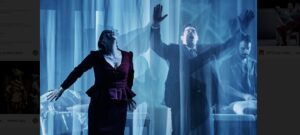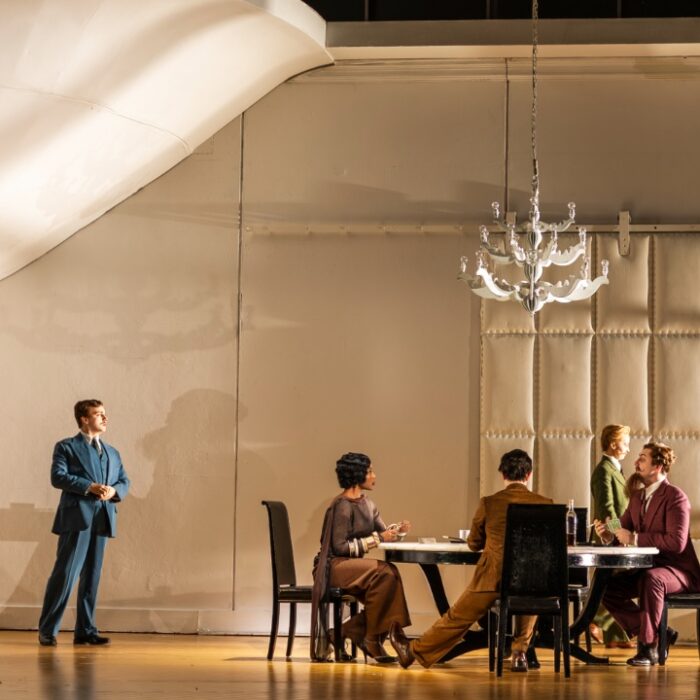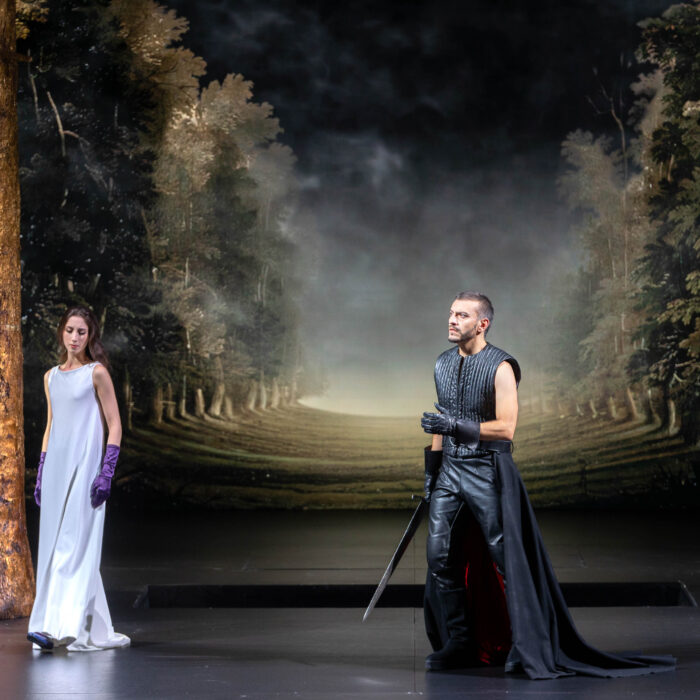
Wexford Festival Opera 2024 Review: Le Maschere
Francesco Cilluffo & Stefano Ricci’s Attempt To Rescue Mascagni Rarity Falls Short
By Alan Neilson(Photo: Patricio Cassinoni)
The Wexford Festival Opera is well-known for its commitment to exploring neglected and unearthing forgotten works written by both well-known and lesser-known composers. Although it has met with considerable success in this endeavor, inevitably there have been one or two failures along the way; after all, many such operas are not performed for very good reasons! Two of this year’s three main presentations can definitely be categorized as successes, the fly in the ointment being Mascagni’s 1901 opera “Le Maschere.”
Having shot to fame with his opera “Cavaliera Rusticana,” Mascagni then struggled to find a consistent style that would repeat his success. His biographer, Alan Mallach, wrote of him “as a man adrift and rudderless in a musical sea without any real direction.” Although he was to write a further 12 operas, he struggled to make his mark, while his great rival, Puccini, met with continued international success and established himself as the heir to Verdi.
“Le Maschere,” the eighth of his 15 operas, was a failed attempt by Mascagni to reassert himself as a force in Italian opera and to challenge Puccini’s dominance in the field. He set out to create “a quintessentially Italian opera” by reviving the spirit of the commedia dell’arte but adapted to suit a modern audience, taking his inspiration from Rossini, whom he saw as having used it as his inspiration for “Il Barbiere di Siviglia” 85 years earlier. Certainly, it was not a misplaced idea, but in practice, it failed. In a neatly organized publicity stunt, its premiere took place at six Italian theaters simultaneously, only to receive lukewarm receptions.
Wexford’s new production does nothing to suggest that the original response was unfair.
Part of the problem is Luigi Illica’s libretto, which is dull and uninteresting; even reading through the plot in the program was a difficult exercise. Mascagni himself had reservations, especially about elements he considered unrelated to the commedia dell’arte, but he went ahead nevertheless. Moreover, for a supposed comedy, “Le Maschere” is not funny. The audience laughed occasionally, but the overall response was more of polite tolerance.
Characters are not sufficiently detailed; they are too flat with little nuance and instead rely too heavily on the commedia dell’arte characters. The upshot is that it was difficult to sympathize with them and their predicaments.
Mascagni’s score was hardly of a higher order. Certainly, there were some pleasing passages; for example, the sinfonia in the prologue and a couple of the ensemble pieces caught the attention, but overall, it lacked the necessary tensions and momentum to enliven the drama, and its workmanlike melodies lacked strength.
Ricci Fails to Overcome the Dramatic Weaknesses
It is difficult to assess the extent to which the director, Stefano Ricci, was partially responsible for the faults, but he did little to improve things. He took an intellectual approach to the piece rather than simply focusing on relaying the narrative and playing up the comedy.
In his program notes, he talks about the meaning of masks in today’s society and how they have become an official uniform, a means of concealing lies and fictions and a way of hiding ourselves. He asked himself if there is a place where a person in modern society is able to take off their masks, concluding that it was indeed possible. His answer was a wellness centre, a place where a person is able to bare themselves both “physically and spiritually” and where they are able to learn from Nature and cast off the influences of social superstructures. By immersing oneself in this environment of “excessive pampering,” Nature amplifies a sense of equality, allowing us to “abandon our outside masks to find ourselves.” All the “strategies of lovers, economic issues, intrigues and deceptions” of the outside world are transformed into insignificant trivia, at which we are able to laugh “even when we confuse ourselves by wearing other people’s masks.” Whether or not one agrees with this analysis or sees it as rather superficial or even misguided, it formed the basis for the staging, and in doing so refocused his attention, and the comedy suffered.
Yet, everything started well. A narrator came onto the stage, interrupted the overture, and introduced the characters of the commedia dell’arte, who entered from the rear of the auditorium dressed in their splendid, colorful costumes and positioned themselves along the sides of the seating area. They then walked onto the stage and discarded their costumes for more relaxing attire, suitable for a wellness centre. It also ended quite well with the characters changing back to their original costumes, masks and all, and started squabbling as they erected barricades and threw clothing at each other.
Unfortunately, the main body of the performance failed to ignite. The narrative trundled along with occasional well-considered metaphorical references to masks, such as with a white curtain that was used to distance characters from the audience, but otherwise there was little to grab the attention. The efforts to inject fun and laughter into the opera that is defined as a “commedia lirica e giocosa” fell flat. Yes, it was amusing in parts, but it was insufficient to carry the drama.
Ricci was also responsible for the set and costume designs. While there can be absolutely no criticism of the costumes, the sets did not impress. Everything was set up to suggest a wellness centre. There was a grassy knoll upon which the clients could relax, surrounded by the comforting spirit of Nature in the form of a planted green bamboo area in front of a blue sky. There was a scene in a massage room with benches and so on. The coloring, however, was a little insipid and generally created a sterile-looking stage. Moreover, it added little to the drama itself, apart from allowing the chorus as residents to watch the antics of the newly arrived customers from the grassy area.
Cilluffo Makes a Brave Attempt to Promote the Music
Francesco Cilluffo conducting the Wexford Festival Orchestra did his best to enliven Mascagni’s music, but with limited success. Although he elicited a nicely paced reading, which was sensitive to the music’s dramatic dimensions, it remained stubbornly uninspiring. There were many pleasing episodes, which Cilluffo did well in developing, but few, if any, that actually grabbed the attention or will be remembered. He also engineered a detailed reading that successfully drew out the musical textures and was particularly adept at building climaxes, but ultimately, he was bound by the pedestrian, albeit inoffensive, quality of the score. One negative point that can be attributed to Cilluffo, however, was the occasional lack of balance between the orchestra and the stage.
Inevitably, given that the singers were playing stock characters from the commedia dell’arte, there was less room for their personal interpretations than is generally the case, and this translated itself into a batch of fairly uninteresting portraits that lacked nuance and depth, so that they remained close to the stereotype. Nevertheless, each produced a well-sung performance, and their combined enthusiasm did bring the occasional injections of vibrancy and tension into the drama.
Rosaura and Florinda, the two lovers, played by soprano Lavinia Bini and tenor Andrew Morstein respectively, were a suitably loving couple determined to overcome her father, Pantalone, who plots to marry her off to Captain Spavento. Bini’s agile, resonant and expressive voice ensured a very strong performance, and her relationship with Florindo was convincingly portrayed. Morstein, reciprocated with an energetic, passionate performance in which his attractive middle register and sensitive phrasing impressed, although a little thinness was detectable as he pushed into the upper register.
Bass Mariano Orozco was a bad-tempered and suitably angry Pantalone, in which he used his rich, colorful voice to express his feelings, while baritone Matteo Mancini produced a forceful performance in the role of Captain Spavento.
The scene in which Arlecchino tried to seduce Colombina, played by tenor Benoit-Joseph Meier and soprano Ioana Constantin Pipelea was cleverly done and definitely the funniest part of the show. While Meier gave a solid singing presentation, Pipelea stood out with her secure, confident performance with her attractive upper register.
Bass-baritone Giorgio Caoduro produced a strong performance as the stuttering servant Tartaglia. The role provided him with plenty of opportunities to display his vocal agility, confident delivery and firm control, in which his rendition of “Quella è una stra-stra-strada” was particularly well done.
Tenor Gillen Munguia gave a busy and expressively convincing performance in the role of Brighella, Florindo’s confidant. Always on the edges of the action, he engaged fully with his role, acting and singing with plenty of confidence and vitality.
The relatively small role of Dottore Graziano was essayed by baritone Rory Musgrave, who made the most of the opportunity with a pleasing portrayal that showed off his voice to good effect.
The Wexford Festival Chorus, under the direction of chorus master Andrew Synnott, was fully engaged and produced a high-quality performance.
The dancers, choreographed by Stellario Di Blasi, created pleasing, although not particularly memorable routines.
Unfortunately, “Le Maschere” is not a particularly good opera. It has its moments, but one can understand watching this production why it is rarely performed. To be fair to its director, Ricci, he did attempt to open up a new perspective, but it did not really work and undermined its comedic potential and detracted from the plot’s simplicity.



